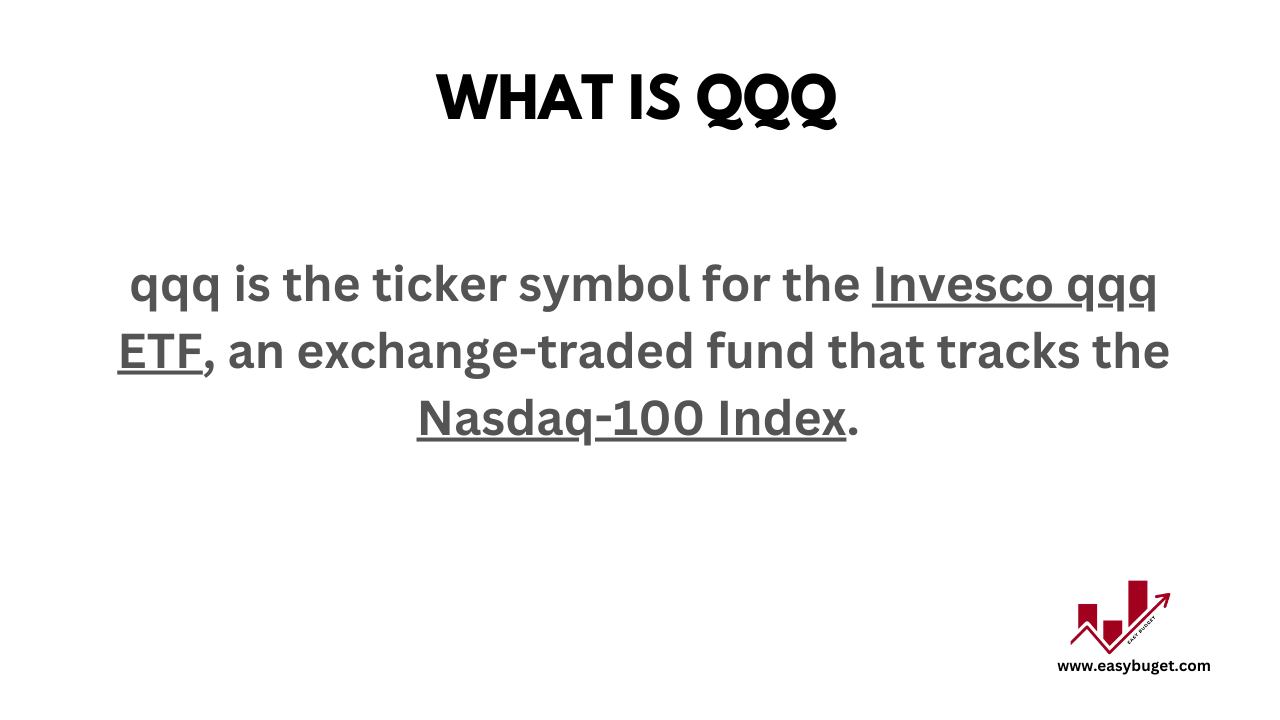Have you ever wondered how to invest in some of the biggest tech giants like Apple, Microsoft, or Amazon without buying each stock individually? Enter qqq, one of the most popular ETFs in the world. With over $200 billion in assets under management, qqq is a favorite among investors looking for exposure to the tech sector. But what exactly is qqq, and how does it work? In this guide, we’ll break it all down for you—whether you’re a beginner or an intermediate investor.
What is qqq?
qqq is the ticker symbol for the Invesco qqq ETF, an exchange-traded fund that tracks the Nasdaq-100 Index. Launched in 1999, qqq has grown into one of the most traded ETFs globally. But what does that mean for you as an investor?
An ETF, or exchange-traded fund, is a type of investment fund that trades on stock exchanges, much like a stock. qqq gives you access to a basket of 100 of the largest non-financial companies listed on the Nasdaq. Think of it as a way to invest in multiple companies with a single purchase.
What is the Nasdaq-100 index?
The Nasdaq-100 Index is a stock market index made up of the 100 largest non-financial companies listed on the Nasdaq stock exchange. While it includes companies from various sectors, it’s heavily weighted toward technology. In fact, tech giants like Apple, Microsoft, and Amazon make up a significant portion of the index.
But it’s not just tech—the Nasdaq-100 also includes companies from sectors like consumer discretionary (e.g., Tesla, Starbucks) and healthcare (e.g., Moderna, Amgen). However, tech is the star of the show, accounting for about half of the index weight.
Composition of qqq
So, what exactly are you investing in when you buy qqq? Let’s take a closer look at its composition.
Top holdings of qqq
qqq top holdings read like a who’s who of the tech world:
These five companies alone make up a significant portion of the ETF, which means their performance can heavily influence qqq overall returns.
Sector breakdown
Here’s a quick look at how qqq is divided by sector:
- Technology: ~50%
- Consumer Discretionary: ~20%
- Healthcare: ~10%
- Other Sectors: ~20%
This tech-heavy focus is one of the reasons qqq is so popular—it gives investors direct exposure to the innovation and growth potential of the tech industry.
Performance history
qqq has a strong track record of performance, especially over the past decade. Thanks to the rapid growth of tech companies, qqq has delivered impressive returns. For example, between 2013 and 2023, qqq annualized return was around 18%, significantly outperforming the S&P 500.
However, it’s important to note that qqq can be more volatile than broader market ETFs like SPY (which tracks the S&P 500). During market downturns, tech stocks—and by extension, qqq—can experience sharper declines.
Why qqq is sopopular?
So, what makes qqq such a favorite among investors? Here are a few reasons:
- Tech exposure: qqq is a straightforward way to invest in the tech sector, which has been a major driver of market growth over the past decade.
- Liquidity: With high trading volumes, qqq is easy to buy and sell, and it typically has low bid-ask spreads.
- Growth potential: Tech companies are known for their innovation and scalability, making them attractive for long-term growth.
Pros and cons of investing in qqq
Like any investment, qqq has its strengths and weaknesses. Let’s weigh them:
Pros
- Diversification: You get exposure to 100 companies with a single investment.
- Strong performance: qqq has historically outperformed many other ETFs.
- Low expense ratio: At 0.20%, qqq fees are relatively low compared to other actively managed funds.
Cons
- Tech concentration: The heavy focus on tech can increase risk, especially during sector downturns.
- Volatility:qqq can be more volatile than broader market ETFs.
How to invest in qqq
Ready to invest in qqq? Here’s how to get started:
- Open a brokerage account: If you don’t already have one, sign up with a brokerage like Fidelity, Vanguard, or Robinhood.
- Search for qqq: Use the ticker symbol “qqq” to find the ETF.
- Place an order: Decide how many shares you want to buy and place your order. There’s no minimum investment—you can start with just one share!
- Monitor Your Investment: Keep an eye on your portfolio and adjust as needed.
Who Should Invest in qqq?
qqq is ideal for:
- Long-term investors seeking growth.
- Tech enthusiasts who want exposure to leading tech companies.
- Diversifiers looking to add a tech-focused ETF to their portfolio.
However, qqq may not be the best choice for risk-averse investors or those looking for steady income (since it doesn’t focus on dividend-paying stocks).
Final Thoughts
qqq is more than just an ETF—it’s a gateway to some of the most innovative companies in the world. With its tech-heavy focus, strong historical performance, and ease of access, it’s no wonder qqq is a favorite among investors.
That said, it’s important to remember that no investment is without risk. qqq concentration in tech makes it more volatile, so it’s crucial to consider your risk tolerance and investment goals before diving in.
If you’re ready to explore qqq further, start by researching its holdings and performance. And as always, consider consulting a financial advisor to ensure it aligns with your overall investment strategy.
Happy investing!

